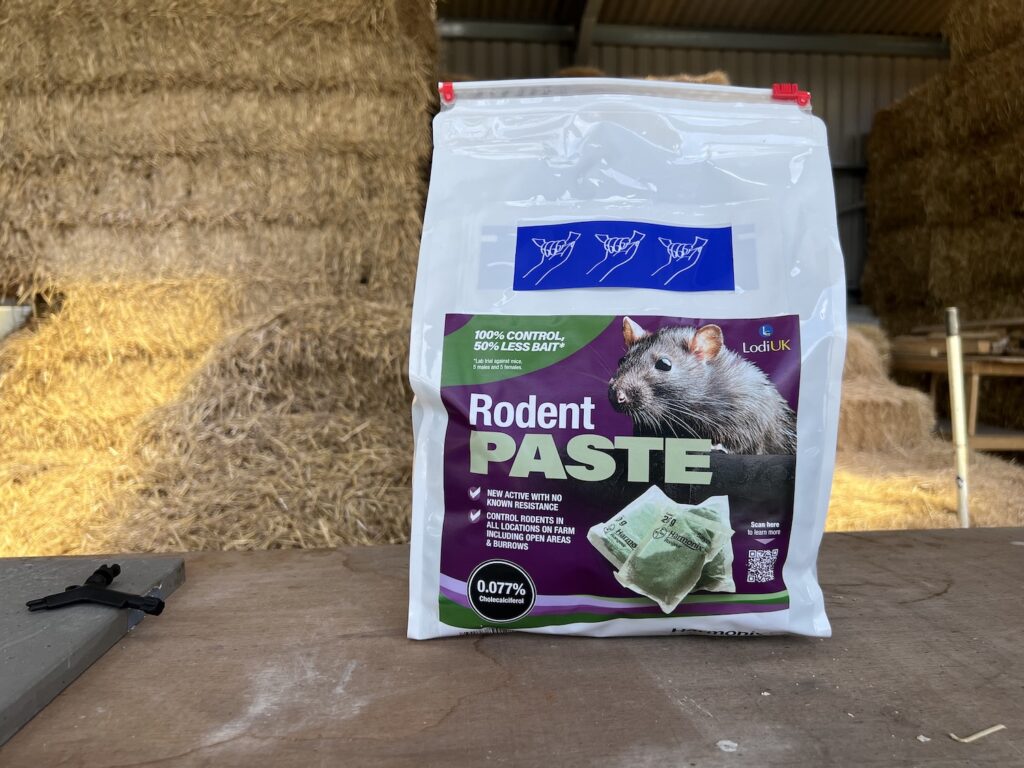Upcoming rodenticide promises to be twice as effective
9th September 2022
Ahead of the October launch of the Lodi Gems Harmonix Rodent Paste, Lodi looks at best practices in rodent control on farm, and the new potential of its next generation active and mode of action.
As a new addition to Lodi’s Gems range, Harmonix Rodent Paste is a highly effective ready-to-use non-anticoagulant rodenticide. It provides farmers with an innovative and flexible solution to rodent problems, which, untreated can lead to disease, property damage, fire risk, and costly repairs, Lodi says.
Key innovations with Harmonix Rodent Paste are:
- Open areas and burrows included on the list of locations where bait can be placed
- Proven to be twice as effective as anticoagulants working in as little as seven days
- Stop feed effect occurs after 2-3 days, using half the bait of an anticoagulant and reducing the risk of damage and disease on farm
- No resistance
- Reduced risk to non-target species when considering non-bioaccumulate and non-persistent properties of the product in rodents or the environment.
Key areas of use when baiting on farm:
- In and around buildings
- Open areas
- Burrows
- Around silage and bales
- Waste areas.
Lodi’s Gems Harmonix Rodent Paste is not the standard ‘in and around buildings’ professional-strength rodenticide. It is classified as non-bio-accumulative or persistent in the environment. Therefore, secondary poisoning to birds of prey and other non-target species is reduced. It can be used indoors as well as in open areas and burrows, giving you greater freedom to protect your farm, Lodi comments.
Burrow baiting can help prevent a neophobic response from rodents as the pests are less likely to search for alternative sources of food. Close monitoring should be done when using Lodi’s Gems Harmonix Rodent Paste, with weekly visits being the minimum recommended.
The product contains 0.077% cholecalciferol which is fast-acting and encourages rodents to cease feeding within two days, reducing activity significantly.
This stop-feed effect also minimises losses of feed as well as the risk of contamination and damage caused by rodents on farms.
The efficiency of the product provides a cost-effective way to control rodents, Lodi reckons. With half the bait you can control the same amount of rodents, making it more efficient.
After the dose, rodents stop feeding and this has three major benefits to the user:
- Environmental impact – bait usage is reduced by 50%, thereby lessening the amount of rodenticides in the environment
- Property damage – rapidly decreasing rodent activity will rapidly decrease the amount of damage committed by rodents
- Risk of disease – a decline in rodent appetite and the eradication of rodents decreases the risk of disease.
Best practice advice
Apply up to 200g per bait point every 3-10 metres depending on infestation levels for rats and mice. Ensure enough bait points are close together with good amounts to ensure bait take early on. Choose to either apply to a board with a nail skewed on and then cover the bait point as an uncomplicated method, or use a bait station. Check within 24 hours and add more if bait take occurs but avoid moving bait points, even if no bait take has happened to one of them.
From day two, the stop feed effect reduces bait take along with activity of the rodents and control can be achieved in seven days. However, ensure bait remains at each location and keep checking points as even 10 rodents left can restart an infestation. Removing the bait after control too early could cause future bait shyness. After 2-3 weeks retrieve bait.
Ensure bait is fixed to bait stations or points to protect non-target species and the environment. Avoid moving bait points or disturbing them other than for replenishing with bait during the week, as urine trails map pathways for rodents so if the bait moves, they may miss it.
Labelling bait points to state the rodenticide is in use is essential to ensure safety while making sure bait points are retrievable, especially around animal food sources such as silage.
Silage pits are ideal areas for rodent infestations to take hold. Maize clamps can provide food, shelter, and water all in one location. Water can remain in tyres securing silage pits even in summer heatwaves. Rodents need to drink water often; water troughs near a habitat encourages activity and is a point of interest, especially in dry weather.
As well as keeping clean and tidy farms to reduce rodent infestation risk, monitoring areas is vital.
Bales provide good harbourage, somewhere to live, so check for signs of rodents and holes around them. Muck piles are potential habitats where they can burrow a hole and live. Hedges up against embankments near buildings and debris are ideal living spaces for them as they are able to climb exterior building walls to find food. Check under sheds and outbuildings beneath concrete and useful nesting areas. Check for holes and activity in hay and straw bales stored in outbuildings and for spilt food.
Further information and training
Lodi’s Gems Harmonix Rodent Paste is an exceptionally powerful rodenticide that controls rodents with half the bait of other products, Lodi says. It must be used as per the technical instructions on the pack and there are many videos you can watch to learn how to use it effectively and safely.
To learn more about how to use it, visit Lodi UK’s website at www.lodi-uk.com/gems-harmonix


